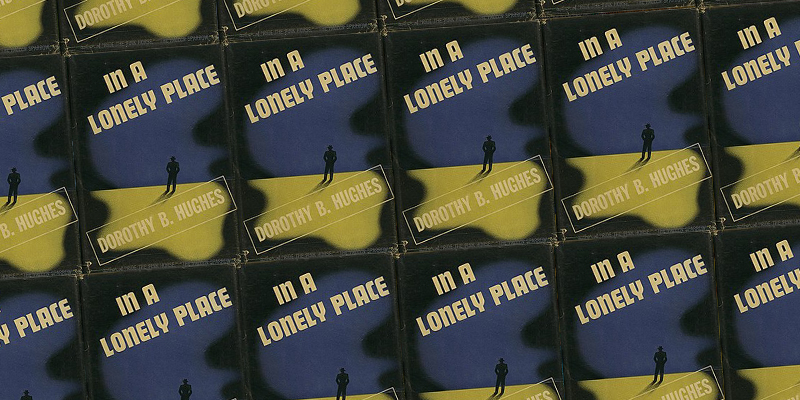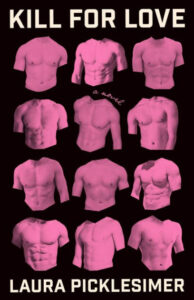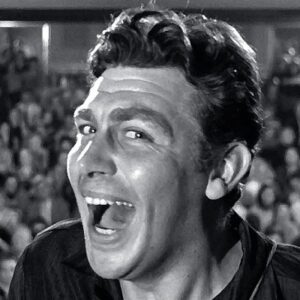Published in 1947, Dorothy Hughes’ noir novel In a Lonely Place is a masterpiece of crime fiction whose influence has extended to both books and films, including a 1950 movie adaptation starring Humphrey Bogart. The story follows a mercurial and mysterious lead, Dix Steele, who is many things: Los Angeles dreamer, war veteran, aspiring crime novelist, conniving grifter, and we soon discover, serial killer. The book, now 76 years old, still feels fresh, relevant and surprising with each new read despite its post-World War II landscape. There are a few key elements that lend the book its thoroughly modern and feminist take.
A Modern Serial Killer
Before Patrick Bateman, Hannibal Lector, Joe Goldberg and even Tom Ripley, there was Dix Steele, a noir name if there ever was one. A keen reader recognizes less than twenty pages into the novel that he is the strangler haunting the West L.A. nightscape and preying on women each month. Removing the mystery behind the killer paves the way for a character-driven journey into Dix’s twisted psychology. Brub, the detective on the case, says early on about the unknown murderer, “I honestly don’t think he ever does escape. He has to live with himself. He’s caught there in that lonely place.” Dix is both cruel and complex. His unreliability parallels later works, from American Psycho to Boy Parts. Increasingly delusional as the hand of the law starts to inch closer, we witness his rationalizations even as we recognize his psychopathy.
Dix’s reckless, desperate nature was once rewarded; in some of the most affecting commentary on the ramifications of the war on veterans, Brub comments to Dix, “I hated it…The callous way we’d sit around and map out our plans to kill people. People who didn’t want to die any more than we wanted to die… As if we’d been killing ants, not men.” Hughes deftly makes her protagonist compelling enough to follow (and at times even relatable or almost sympathetic) while also refusing to overly explain or excuse his horrific crimes. This had a huge impact on the crafting of my own serial killing protagonist Tiffany in my debut crime thriller Kill for Love.
The Grifter
Like Tom Ripley, Dix takes over a rich friend’s apartment, assuming his fashionable wardrobe, expensive car and even his cigarettes. Dix’s claim that he’s subletting the place so he can work on writing his own crime novel is an easy boast that, coming from a confident, suave man, does not raise many questions, at least at first. Dix never bothers to write a sentence the entire time. Instead, he relies on his wiles and a heavy dollop of brazen charm to enter the higher social circles of Brentwood country clubs.
Equal parts enticed and repelled by a post-war landscape of materialism, his character is reminiscent of this summer’s hit beach read, The Guest. Dix remarks, “The easiest way to get money was through those who had money.” Like Emma Cline’s protagonist Alex, readers can’t underestimate the desperation that results from trying to keep the grift going. As the novel continues, it’s like watching a slow-moving car crash. There is just as much suspense built into Dix’s avalanching lies as his murders. He starts to take chances, returning to the scenes of his crimes, pressing his luck further. Like Alex, it seems he might want to get found out. “That was what quickened his mind. That was what put zest into the game. To take the dare.”
A Noir Paradise
The idea of murder and brutality over beach bluffs and glinting ocean would be a model for contemporary murder and crime shows like Big Little Lies. The darkness behind sunny California would later captivate imaginations and fears in the 1960s with the Manson murders. Early in the novel, Hughes shows Dix cruising down the California Incline. “From the open windows, he knew the day was a sultry one, September was summer in California.” There is palpable danger in this paradise, which grows to a fever pitch every time the sunny landscape transforms to night.
Understated Violence
Dix’s crimes are brutal and abhorrent: he rapes and strangles most of his victims, but Hughes keeps all the murders off the page. Its effect is chilling since it lets the reader fill in the missing moments and gaps. This restraint also prevents the book from falling into titillation or unnecessary violence toward women. When about two-thirds into the book we get this passage, its building dread is more powerful than any detailed play by play of murder. “There was only sound, the swish of the dark wet water over the cold sand… The water was the voice of a girl, a voice washed by fear, repeating over and over, no…no…no... Fear was a girl whispering a word over and again, a small word you refused to hear although the whisper was a scream in your ears.”
More than Femme Fatale
Like any classic noir, there is a femme fatale who presents herself early in the novel: the gorgeous Laurel Gray, but this trope is quickly subverted as we know Dix is the one who cannot be trusted. Laurel’s power is evident in her first scene. “She stood in his way and looked him over slowly, from crown to toe. The way a man looked over a woman, not the reverse.” As they quickly fall into each other’s arms and beds, the question becomes, will she get out of their relationship alive? However, Laurel is no damsel in distress. She can stand on her own, and her growing suspicions provide a commentary on the way women often must be perceptive of men’s subtle misogyny.
A Surprising Detective
Cops in crime novels can be depicted as either overly heroic or bumbling idiots. Brub, In a Lonely Place’s lead detective, is a fleshed out character with one major blind spot: Dix served with him overseas in the war, and Brub always gives him a benefit of the doubt he won’t afford to others. Luckily, his wife Sylvia, like Laurel, can spot glimmers of darkness behind Dix’s cool exterior. “She wasn’t looking at him, yet Dix had a feeling she was seeing him. And probing him with her mind.” It is two women—Laurel and Sylvia—who pose the greatest threat to unlocking the violent secret Dix harbors, not the detectives scurrying across beaches for clues and hosting stakeouts at diner drive-ins. In Hughes’ feminist noir tale, two very different but equally intelligent and resourceful women are the best hope against the killer’s escalating violence.
***


















